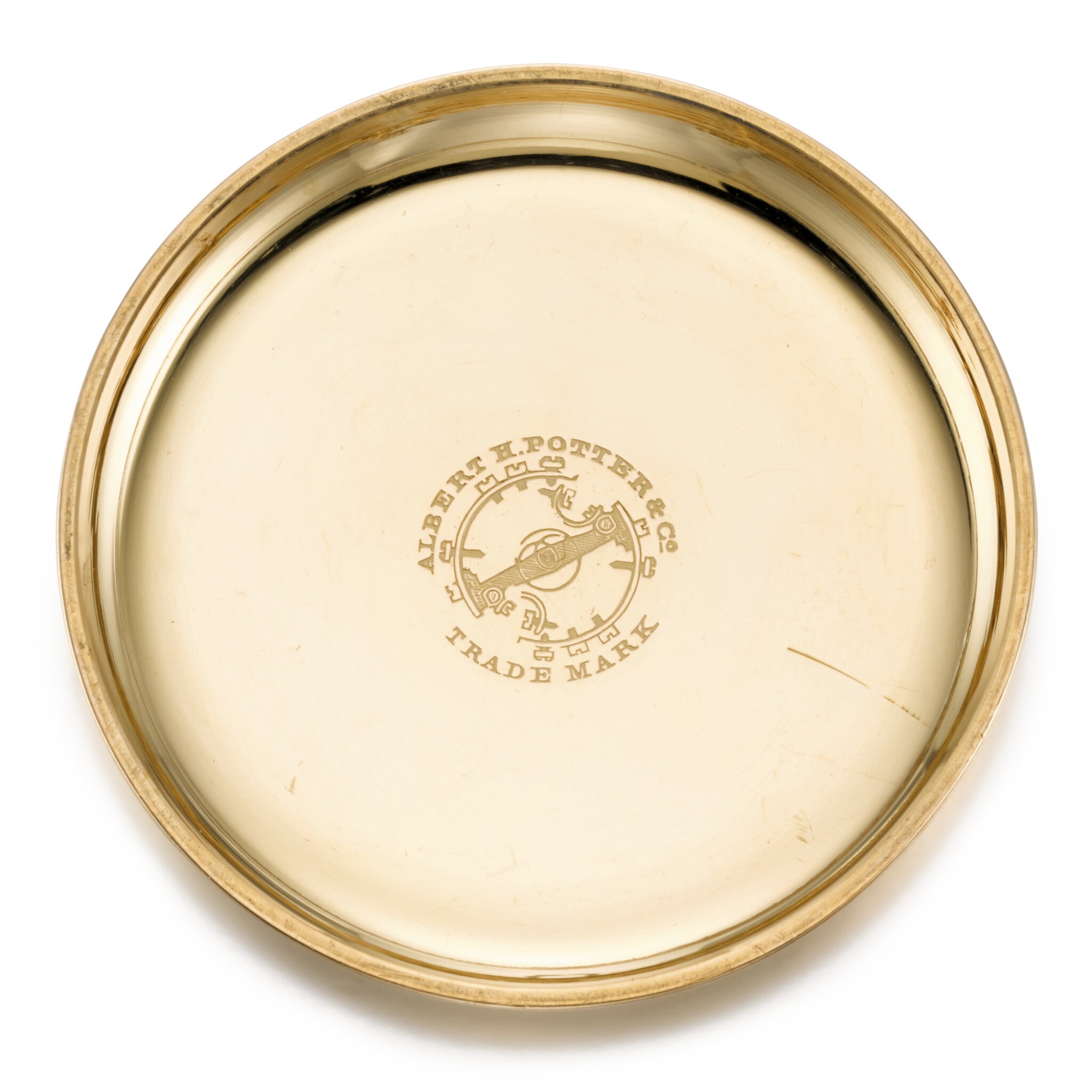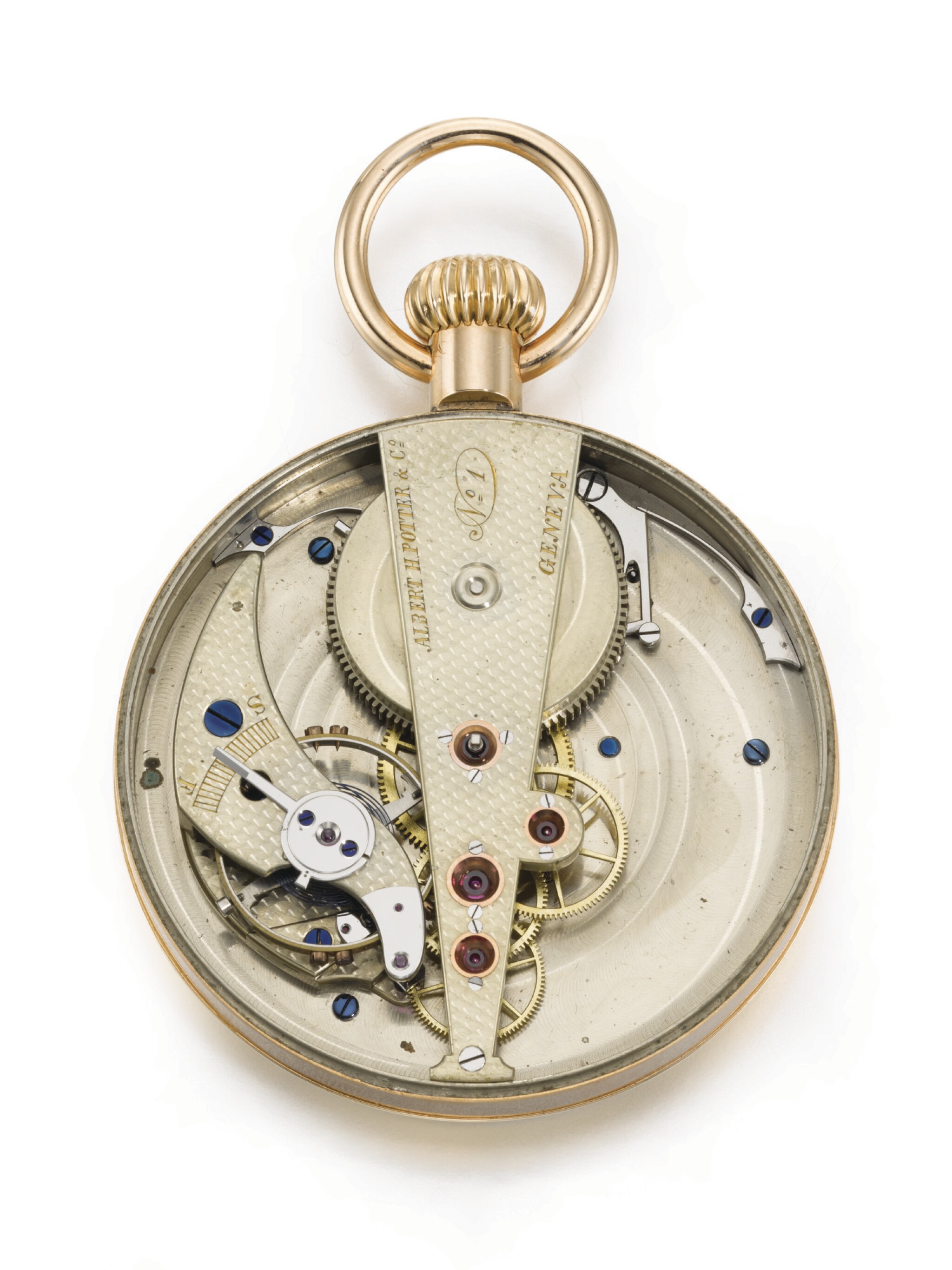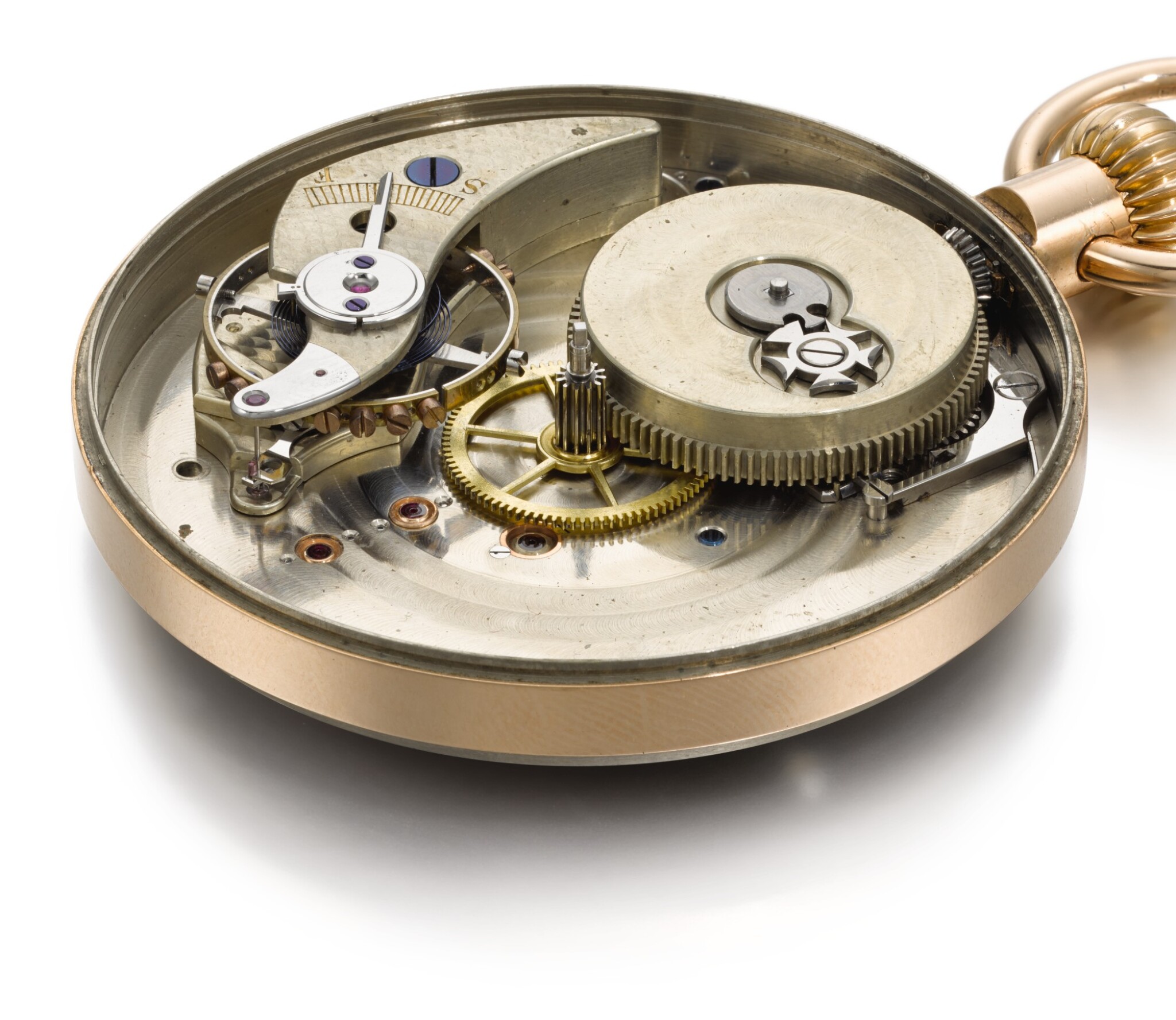Watch Data
Gold Watch no. 1
Case: Gold, with Albert H. Potter balance wheel trademark stamp
Dial: White enamel, regulator style, Roman numerals, subsidiary dials for hours & seconds, blued steel hands, signed "Albert H. Potter & Co., Geneva"
Movement: Nickel, unique single tooth escapment
Provenance:
1887 - Potter, Geneve
19?? - Collection of the Director of the Geneva School of Horology
???? - Beyer collection, Zurich
2003 - Antiquorum, 16 Nov 2003, "Albert H. Potter & Co, Geneva, No. 1, made circa 1887. Exceptional, highly important and unique 18K gold keyless watch with regulator dial, special winding/setting system, special plate construction and special single-tooth escape wheel lever escapement. C. Four-piece, "bassine et filets", polished, the band incorporated into the movement, pendant of patented design, detachable glazed cuvette. D. White enamel, mounted by three feet secured by screws from the pillar plate, double sunk with small radial Roman hour chapter set at the top, central outer minute divisions with radial five-minute Arabic markers, subsidiary sunk seconds. Blued steel "lozenge" hands. M. 47.4 mm (21'''), nickel, unusual construction in which the pillar plate comprises a surrounding ring, circular decoration on the pillar plate, V-shaped bridge for the train mounted on one side by pins to the pillar plate ring decorated with spotting pattern, bridges for the escapement, going barrel with Maltese-cross stop work, 22 jewels in gold screwed settings, patented single-tooth-escape wheel lever escapement consisting of a small plate fitted on the pinion with a single ruby tooth, unusual cut bimetallic compensation balance with gold temperature screws and platinum quarer screws, blued steel Breguet balance spring, unusual keyless winding/setting mechanism with engagement setting mode by means of a vertical motion of the intermediate setting wheel bridge.Signed on dial, case and movement.Diam. 49 mm.
Notes
Previously in the collection of the Director of the Geneva School of Horology.The present watch represents the ultimate in Potter design, based on years of experience.With the present watch, Potter wanted to revolutionize the modern watch, just as Lepine had done 100 years previously. This watch, marked No.1, appears to be a one-of-a-kind piece; no other is known to date. Potter's layout is ingenious and innovative. Potter revolutionized watch design twice; the first time when still in America, he designed and patented his famous plate designs, one for a lever escapement (see Antiquorum Nov. 11, 2001, lot 299), the other for his pivoted detent escapement (see Antiquorum Nov. 11, 2001, lot 298).After his arrival in Switzerland in 1875 his production was chiefly based on these two designs. Within a decade, he sought to improve those already famous designs, to create a perfect watch, easy to manufacture, easy to disassemble for cleaning, of high quality and easy for the owner to read and to set. Potter made considerable improvements, some of which he patented.* The pillar plate is designed to incorporate the band, thus eliminating the need for a further case band. The bezel and the back are snapped onto it. This ingeniously simplified design was patented on April 5, 1887 (US patent No. 360475-7).* The pendant was fixed to the pillar plate band by means of two prongs and two additional pins. This was patented on the same date under the No. 360478.* The train was arranged in a straight line, thereby requiring only one narrow bridge for the entire train. It was fitted to the pillar plate band and was fixed by means of two pins on one side.* The winding/setting mechanism: the intermediate setting wheel was set on a spring-loaded bridge, which was held by a lever controlled by swinging the bow. Mode changing from winding to setting is achieved by means of Jules Jürgensen's bow setting arrangement-when the bow is pulled forward, the watch can be set.* The escapement: Potter devised a special lever escapement with escape wheel having only one tooth. It is simply a round ruby pin set on a steel plate and staked to the pinion. This he secured by patent No. 360474 on April 5, 1887.* The dial is of the regulator type, very elegant and easy to read. For securing the dial Potter chose a system often used by Vacheron Constantin in which the dial is fixed to the pillar plate by means of three screws on the dial feet.* The balance has small "wings" at the arm for poising "in the raw", that is, before the screws are put in. This insures that temperature compensation adjustment will not affect poising. Potter also made the cut further from the arm to decrease centrifugal error. At the same time he changed the ratio between the thickness of steel and brass laminae.In designing the balance, Potter went against current practice, which had evolved from the theory of marine chronometry. Perhaps deducing that pocket watches presented different requirements than marine chronometers, he used a more rigid balance and changed the laminae proportions from those generally used, which were commonly assumed to be perfect but had never actually been put to the test. This type of balance was less subject to centrifugal force distortions, with decreased Middle Temperature Error.This watch, with its revolutionary design, is very likely the prototype for a watch which embodied one of Potter's ideals: a high-quality, low-priced, and therefore extremely popular, watch. Potter's principal idea, visible in the present watch, was to make the back plate of the movement an integral part of the case, so that the case body and back plate could be stamped with one blow from sheet stock, with no machining necessary. It is interesting to note that over 100 years later a similar idea, that of incorporating the movement plate with the case, can be seen in the famous Audemars-Piguet self-winding wrist tourbillion.Potter took out several American patents related to the ideas embodied both in this watch and in the "Charmilles" watch:- 360477 for a "watch case & movement plate combined"- 360478 for a "watch case center and pendant"- 360818 for a "manufacturing watch plate & case"- 360819 for a "watch plate" all dated April 5, 1887, and two additional patents- 418381 of Dec 31, 1889 and- 425342 of Apr 8, 1890, both for "watch stem-wind case part of watch".All the patents were taken out in the name of the New Haven Watch Co., which in 1887 became the Trenton Watch Co. The manufacturing was eventually entrusted to J.J. Badollet, who had a factory in the town of Charmilles, hence the name of the watch. The watch consisted of 70 parts, not including screws, and sold for between $3.00 and $4.00. Production lasted from the early 1890s until 1895 and probably no more than 25,000 were ever made. In 1892, Robert Ingersoll's one-dollar watch dethroned the "Charmilles" watch, resulting in financial disaster for Badollet and Potter. The present watch, a horological masterpiece, remains a prototype testifying to Potter's never-realized dream: that of making a watch of excellent quality yet easy to manufacture. "
2020 - Sotheby's, 16 Jun 2020, est CHF40-60,000, sold CHF40,000, "ALBERT H. POTTER & CO., GENEVA [Albert H. Potter & Co.,日內瓦] | AN IMPORTANT AND POSSIBLY UNIQUE GOLD OPEN-FACED KEYLESS WATCH WITH UNUSUAL LEVER ESCAPEMENT AND SINGLE RUBY-TOOTH ESCAPE WHEEL, AND REGULATOR DIAL CIRCA 1887, NO. 1, • Movement: unusual v-shaped central bridge with pearled machined decoration and screwed gold chaton jewels, similarly decorated s-shaped balance cock with index regulator, lever escapement, the patented escape wheel with single ruby-tooth, bi-metallic compensation balance, going barrel with Maltese-cross stop work, signed Albert Potter & Co., Geneva, No. 1 in his trademark logo
• Dial: white enamel regulator-type, outer Arabic minute ring, two subsidiary dials for hours with Roman numerals and seconds with Arabic numerals, signed Albert H. Potter & Co., Geneva
• Case: 18ct gold, plain polished band and case back, rounded bezels, hands set by folding the bow forwards to the case, centre of the inside case back stamped Albert H. Potter & Co.
diameter 49mm. The present lot exemplifies Potter at his most ingenious and, to the best of our knowledge, may be a truly unique piece. Potter had built a reputation for himself after patenting a new design for a lever escapement and a pivoted detent escapement. Following his move to Switzerland in 1875, he sought to improve upon those designs, thus resulting in the present piece in 1887.
Most likely a prototype, this watch embodies Potter's desire to create a high quality affordable piece easy to clean, read, and set. Potter designed the pillar plate to incorporate the band that the bezel and back snap into, thus eliminating the need for another case band. He arranged the train of this piece in a straight line, so it requires only one bridge. Most interestingly, this piece showcases Potter's patented single-tooth lever escapement, made from just a ruby pin set on a steel plate set to the pinion. He patented this design on 5 April 1887.
Potter made the back plate of the movement an integral part of the case so that the case body and back plate could be stamped by sheet block with one blow, with no need for machinery." |






|
|

